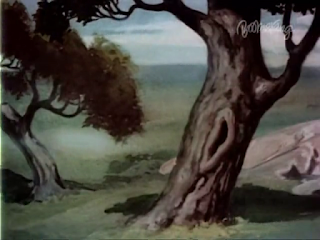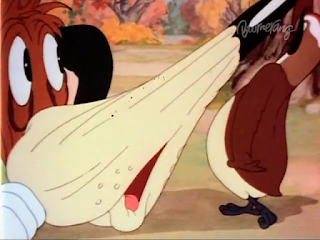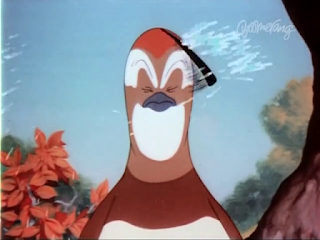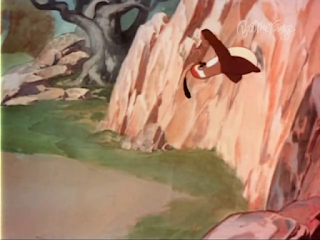Release date: 2/15/41 (according to BCDB)
This cartoon is in the public domain, and has no official DVD or BR release. It may be on some PD releases, but I don't know of any specific discs. Despite its PD status, it was quasi-remastered in the 1990s and shows up on Boomerang.
You may view a crisp Boomerang-sourced print of this cartoon HERE.
<><><><><><><><>
Fred Avery's time at the Leon Schlesinger studio was growing short. By the final months of 1940, he had made significant innovations to studio animation: faster pace and timing, breaking the fourth wall in a more intimate way, harder-hitting humor (much of it sourced from radio shows, movies and other popular culture of the day) and the development of the screwball character. Add to that Avery's debut of the topical spot-gag cartoon, which used deliberately corny humor as a weapon, and, via a sardonic narrator, bridged the experience between filmmaker and spectator, and his body of work is as game-changing as the Walt Disney studio's.
Having recently crested with the impeccable A Wild Hare, Avery had no further heights to reach with Schlesinger. His cartoons of the 1941 season maintain a high technical quality. The worst ones have some nugget to be be mined later in his career (e.g. the hair-in-projector-gate gag of Aviation Vacation). Avery was ready and willing for a more rewarding berth in the world of animation. He would reach that goal by 1941's end, after a brief stint at Paramount, with M-G-M--the glossiest movie factory in Tinseltown. Known for their frothy musicals, "important" big-budget literary adaptations and costume dramas, feather-light comedies and their early championing of movie franchises (Calling Dr. Kildare!!!), Metro-Goldwyn-Mayer first released Ub Iwerks' Flip the Frog cartoons and then lured Hugh Harman and Rudolph Ising from the early Warners animation studio.
M-G-M cartoons didn't shake the Harman-Ising influence til the mid-'40s. Though the mawkish sentiment went out the window first, the lush, ponderous animation techniques weighed these cartoons down--including Hanna and Barbera's popular "Tom and Jerry" series. Harman and Ising weren't all slush. Swing Wedding, released in 1937, was more frenzied than anything Avery had yet done.
A revival of their WB Bosko series, with the main character now clearly an adorable li'l stereotyped African-American tot, had a non-PC but amusing run of films in which the star, assigned to take fresh-baked cookies to his grandmother's house, runs afoul of larcenous frogs who want, need, lust for and covet those cookies, which must have been incredibly tasty.
A revival of their WB Bosko series, with the main character now clearly an adorable li'l stereotyped African-American tot, had a non-PC but amusing run of films in which the star, assigned to take fresh-baked cookies to his grandmother's house, runs afoul of larcenous frogs who want, need, lust for and covet those cookies, which must have been incredibly tasty.
 |
| Avery-esque exaggeration in The Lonesome Stranger (1940) |
To become faster and funnier, animation had to shed its layers of storybook detail and old European visual influence. A spartan playing field with crisp, expressive characters was ground zero for Hollywood cartoons by the mid-'40s. This would be Avery's most lasting influence as a filmmaker.
At 1940's end, Avery wasn't there yet--no one was. Most of the moldy-fig stylings of the 1930s were gone from the work of Avery, Friz Freleng and Bob Clampett, with Chuck Jones soon to follow, once he realized he was capable of making his audience laugh instead of ooh and aah. 1941 is an important but troubled year for the Warners cartoons. All the units are at a turning point; Avery is at a crossroads. After delivering a masterpiece with Wild Hare, and having perfected the spot-gag format with Cross Country Detours, what was left for him but to repeat himself?
It can't have been a comfortable place for him. He pushed forward. There are a handful of high-quality cartoons yet to come in his Schlesinger period. But there are films that aren't worthy of him, and films that he made not from inspiration but because he had to.
 |
| From an appendix to the MPAA Production Code |
Here's where a stack of inter-office memos would be welcome, but they're all buried somewhere in the California desert. The razzberry--as gesture and sound effect--was banned by the Hays Code. (It was deemed a no-no by 1930, although Hollywood ignored this earlier edict and went on razzing.)
This was the streetwise vulgarity, so recently rife in movies, that Hollywood wanted out of his product. Warner Brothers was among the studios hardest-hit by the Code. They had a reputation for being earthy, coarse and snappy, and to their credit, they did figure out ways to sustain that style post-Code.
Anyone making animated cartoons in 1940 would have known the sound effect was taboo. Watch a string of cartoons from, say, 1932 to 1936 and you'll notice its sudden demise as part of a concerted effort to make animation cuter, cuddlier and more puerile. This was, in part, an influence of Walt Disney's films (which were already smoothing over their rowdy edges during the early years of the Depression). It also shows how the Code curtailed the vitality of studio cartoons.
Avery was a revolutionary agent in the return of rowdiness to the animated film. His success by 1940 was evident in all studios getting faster-paced, more topical and rough-and-tumble and making asides to the audience. Avery, the Che Guevara of animation, hit a wall with The Crackpot Quail.
The cartoon was rejected by the Hays office. "The print at UCLA could be Warners' first answer print," Beck told me. "It's otherwise a mystery as to why it exists." Before the cartoon could find general release, every instance of the "razz" had to be redubbed with a new, Code-friendly sound. This was an expensive folly for Avery--one that likely didn't sit well with Leon Schlesinger and the front office.
Why would a film-maker who had been in the business through the transition to the Code, and had over 50 films to his credit, commit such a reckless and potentially career-damaging move? We can only guess. Something happened to spur this behavior, which will rise up again a few films from now.
Its backstory aside, The Crackpot Quail is an average-quality work--leagues above the abyss of The Haunted Mouse, which may or may not have preceded this film in production (both cartoons shared the release date of February 15). Loaded with handsome animation by Robert McKimson, Virgil Ross and other Avery unit stalwarts, it's visually pleasant and has a few prime moments.
We start with an idealized image of doghood, then truck back to show its relationship to the cartoon's reality:
The owner of these lofty expectations is Willoughby. Voiced by the director, Will is not a paragon of pointer-hood, but this anonymous billboard image inspires an attempt at self-improvement.
(after a deep sigh)
"Heh heh... oh... boy... heh heh...that's the--that's the life.... I'm gonna be a pointer an' catch me a quail!"
"...and I will, too!"
The dullness of the 1939/1940 animation style is just about gone here. Warner Brothers cartoons will not look fully beautiful until 1943's season, but the worst of the symmetrical moldy fig designs and contours are gone. At M-G-M, Avery will eventually iron out all superfluous details to his character designs and stress a clean, streamlined chassis--figures that could move faster, since they had less detail to weigh them down on-screen. Willoughby has heft, wrinkles, tufts and is handsomely put together. He is fun to watch and fun to hear, thanks to Avery's stellar voice work.
 |
| Willoughby model sheet from this cartoon |
Willoughby has a Pavlovian response to his hunting fantasy, then prepares to take off for no particular place. A languorous pace gives us wonderful poses as it tries our patience:
We barely see Willoughby collide with a tree, some four feet from his starting point. The camera continues south until it realizes that there's no action. It tracks back to find the dazed and concussed canine.
Willoughby is keen enough to pass off his mishap as a joke:
"Heh heh... tree!"
The reality of his confusion--how did that danged thing get in my way? he thinks, as he nurses a familiar sore spot--gives a touch of melancholy to the moment. As Avery's pace accelerates in the mid-40s, such moments become rare in his work.Then we hear the first of those expensive overdubbed whistles. I would imagine that the original noise--a constant rubbery razzing--would get old quick. It's in line with Avery's tendency to annoy his captive audience, but even that has its limits.
Willoughby slowly takes in this aural data.
Camera pans stage left to rock.
Whistling increases in intensity and frequency.
The quail's dilemma--perhaps the aspect of his life that has driven him to be a screwball:Cut to close-up for some casually paced character animation. The following violates a golden rule of Cartoonity: a screwball character can be likable (as with Bugs Bunny and Daffy Duck), obnoxious (Blackie Lamb, Woody Woodpecker) or alienating (Screwy Squirrel) but he/she cannot also be adorable. A small attempt is made here to evoke a reaction of "Oh, he's so cute!" from somewhere in the cheap seats. It's not done with great conviction, so I'll give Avery and Co. a pass here.
Avery's hand as artist really shows when the quail is smiling. His cartooning style is often engulfed in this period, as the Schlesinger artists work out a palatable style of more sophisticated animation design.
This isn't funny enough to merit the sheer amount of time it takes on-screen, but the animation is charming, and for a moment, this bird is appealing.
A little dab'll do ya.
Cut to a familiar Willoughby action.
What follows is familiar stuff--clueless and essentially harmless predator; prey whose intelligence far outmatches predator, entitling him to a playful, mischevious attitude; much humor predicated upon the predator's lack of smarts. And, of course, much chase. Chase cartoons are the given of 1940s animation. The action enabled a simple storyline, usually a cast of two and opportunities to try out gag ideas without upsetting the apple-cart.
If these seem less distinguished than the one-shot cartoons, where a comedic notion had potential to spread itself out, sans the encumbrance of "star" characters (as was Avery's preferred mode), they are the most common cartoon type of '40s Hollywood animation. Few did them better than Avery. Though much of this cartoon feels phoned in, the vibrance of its animation and some formal experiments work to its advantage.
And now, back to our cartoon-in-progress:
Quail surprises dog.
"Whaddaya say, doc?"
"Pardon me, shorty..."
No point in quoting the dialogue. The scenario is self-evident. This scene gives us the biggest tell of the short's original, censor-offensive soundtrack, as Willoughby makes an unmistakable, messy razzberry sound. Quail cringes in his spray of spittle.
After a moment to recover from this downpour, quail plays along.
Quail attempts to mislead Willoughby by imitating the bob-white's call (an ornithological in-joke, as the quail is also known as the Northern bob-white).
...with a clever wolf-whistle, augmented by his contoured pantomime of a 36-24-36 fizeek.
Quail is game for harrassing this dumb canine. Willoughby seems skeptical.
Willoughby's currency is sniffing. Quail given invasive nasal once-over.
The nickel finally drops. "Saaaaaaaay. Wait a minnit."
"You're a quail!" Nice matched cut to a close-up.
"He's a card, ain'ee?"
(plops dog's paw to the ground)
Quail confirms dog's suspicion with tinnitus-causing reply; adds piercing whistle just to be a jerk.A close-up like this offers fun in playing with the adversary's facial features, and our quail does not ignore the obvious.
Cartoon Rule 344a: If at all possible, screwball protagonist shall make a fancy, ballet-like exit as adversary recovers from molestation. Suitable music shall accompany said action(s).
And the chase proper begins at 3:11. I'll bet you can't guess what happens next.
Camera continues to pan into the empty woodland--a bit that's funnier than Willoughby's well-timed tree collisions.
Yep, another tree.
We now witness an Avery First: a diagrammatic chase sequence with stylized animation synced to a music cue (throaty flute or piccolo for quail; phlegmy trombone for dog). This is a bold attempt to do something different with familiar material. Avery will perfect this moment in his M-G-M masterwork Lonesome Lenny (1946).
Wonderful dry-brush cel painting that no one but animation nerds have ever seen.
Highlights of the chase interlude:
A hollow log is always good for a gag--and here's a subtle one
in which the quail enters the log first but exits last.
Another playful variant upon familiar turf continues this bit of business, as quail outruns dog.
"Good morning, neighbor!"
The nickel again drops.
"That was the quail!" Willoughby's delivery smacks of Lon Chaney Jr.'s Lennie, discussed a couple of posts back in conjunction with Of Fox and Hounds.Thanks to Ian Soden for spotting this animation drawing, used as a color guide by Ink & Paint, that's almost spot-on to the next frame grab...
More of that dry-brush goodness. Implicit irony: the most detailed and labor-intensive cel paintings tended to register subliminally, if at all. I make a point of capturing these moments in tribute to the ink and paint people who did such beautiful work on these cartoons.
No need to explain. Camera does not pan until after the collision.
By now, this running-into-trees bit has worn out its welcome just a tad, just as Avery liked it. Nothing seemed better for him than to introduce an amusing (or irksome) gag and then drive it into the ground. Razzing the audience is a staple of his cinematic experience.
Sniffing has not paid off for this canine so far, but it's all he knows. Avery and Stalling must have felt this bit was a knee-slapper. Stalling's cue is an overly-bombastic "comedic" piece of music, and Avery lets the snuffle go on for almost 20 seconds, including a novel second shot with a tried-and-true animation gag.
Might as well do some water gags...
Underwater visual effects, an extra expense to film and animate, must have pushed the budget up on this cartoon. For all this, we get the familiar "school of fish" business, garnished with spectacular takes when that nickel drops yet again.
A Stalling favorite, "The Umbrella Man," is the leit-motif for this aquatic mind-fudge.
Some ace diagrammatic comedy rescues this moment. No one did this better than Avery.
Quail trips upon reaching terra firma in an unusual moment.
Quail puts topknot-thingie to work as a windshield wiper.
Startled Willoughby is intent on catching this bird.
The stick is quail's salvation.
Quail takes a second look at the stick, followed by this brief stick close-up. Point is made to the viewer. The joke is still quite funny, aided by great accurate poses of dog excitement.
Willoughby knows nothing but the mindless pursuit of stick.
A foggy voice of realization calls from deep in the dog's recesses.
(sound of nickel dropping not included)
We cut to a close-up as Willoughby becomes furious. This piece of animation looks for all the world like something from Bob Clampett's unit. It is most un-Averylike.
Yep...
The acceleration of action here is remarkable.
"'Nuther tree."
Willoughby emits a couple of bearish "ruff"s as he sprints towards his prey...
"That means I'm gettin' plenty sore!"
As a passage from "The William Tell Overture" (familar to 1941 audiences as The Lone Ranger theme-tune) speeds into warp-drive on the soundtrack, Willoughby's windmilling body parts erupt into a burst of movement and motion. It is a moment worthy of Avery's M-G-M work, and must have made his peer's jaws drop when the film was new.
In a moment that harks back to Avery's first Schlesinger film, Gold Diggers of '49, Willoughby becomes a hurtling blur of speed. And as action always leads to reaction (in real life and in cartoons) we know this will have an orgiastic conclusion.
Acceleration duly noted by quail, who scrambles behind a tree. In each pose, speed and thrust are stressed. This is innovative work that looks towards the future of animation.
Quail's delight turns to surprise, then horror as the speed hits a wall (a number of walls, amidst other debris).
The orgy of destruction, pasted together in two parts for your entertainment:
This takes up 25 seconds of screen time, and plays another neat trick. We hear sound effects of destruction and the screeching of brakes as we see what has just happened. It gave the scenic artists a chance to show off, and piques the viewer's interest as the film reaches its close.
I once heard a veterinarian say, of a pug dog, "no brain, no pain." One can assume this rule applies to Willoughby. After this orgy of destruction, he has not a scratch. One last time, the nickel drops...
...and our put-upon predator makes lemonade of the whole affair.
"Huh huh... LOTS of trees!"
And, not for the first or last time in a Hollywood cartoon, predator takes on prey's personality as we iris out.
The Crackpot Quail, on first viewing, might disappoint. It isn't the transcendent film experience of A Wild Hare (and few cartoons are or will ever be). What seems, on the surface, a rehash of familiar stuff reveals some of the incremental changes in viewpoint and policy that chaperoned Fred Avery from newbie director to seasoned film-maker, and made him ready for the quantum leap to his finest work.
What happens on-screen is so-so. How it happens is what matters. Avery was still a far piece from the streamlined brilliance of his 1940s M-G-M work, in which 11 was the norm and each film offered new horizons and boundaries to break and surpass. It is always thrilling to see the birth of a notion. in these Schlesinger cartoons, that Avery will nurse to perfection at Metro.
Avery's colleagues Robert Clampett and Chuck Jones would have similar breakthroughs during the war years. Clampett's string of brilliant mid-'40s cartoons was cut short by his departure from Warners animation. After peaking with a trio of masterpieces (The Great Piggy Bank Robbery, Book Revue and Kitty Kornered), he perhaps had nowhere left to go--except down, which he did, despite the popularity of Beany and Cecil (a series I've never been able to appreciate, and believe me I've tried). Jones found his groove, was an early adapter to the cartoon modern style, and, in concert with Michael Maltese and Maurice Noble, created a body of work that is as important as Avery's and as lasting and influential. (Friz Freleng also grew as a comedian and film-maker, with one great cartoon after another through the early '50s, but his was a less showy agenda than the other major creators of Warners cartoons.)
This cartoon would seem old-hat in a few years, as Avery's mid-to-late-1940s work peaked. Quail's similarity to the early M-G-Ms, which are slower-paced and more steeped in the Harman-Ising look and feel, makes the film a strong bridge between eras. There's still much we can learn from the pacing, shot choices and thrilling acceleration of The Crackpot Quail--barely concealed beneath its ordinary appearance.
UP NEXT: Another step towards Metro: Tortoise Beats Hare.



















































































































































































































































































The 1939-42 period was basically an on-screen animation class at the Schlesniger studio. Avery and the other Warner directors knew by 1938 what was funny, but the next four years were spent learning how to best animate it funny, which in part meant the elimination of a lot of unnecessary lines and details on the characters that late 30s efforts while improving the overall look of the designs. That was especially a problem at Harman-Ising, where were rife with super-detailed characters (the studio that actually figured out then answer first of course was Disney -- you could look at a 1940s effort like "Window Cleaners" and see that the main characters had been smoothed out, and now had only the details needed to get the personality animation across and tell the story. They just wouldn't make any real Avery-type use of the advance until Jack Kinney's Goofy sports cartoons).
ReplyDeleteStory-wise, "The Crackpot Quail" takes the "I know every tree in this forest" line and gag from "Of Fox and Hounds" and turns it into an seven minute running gag. Tex's heart is still totally with the dog here, so it pretty much sucks all the oxygen out of caring all that much about the Bugs-like title character. It also goes to show how much Bugs needed Elmer as his foil in "A Wild Hare" as not simply a dumb character but a dumb character with a hunting rifle. Avery could allow his rabbit to hammer away at him to the audience's enjoyment in ways the quail couldn't here, and even Bugs can't in "The Heckling Hare".
Funny you should mention the Clampett comparison of Willoughby's face, since it reminds one of the same reaction Elmer's pooch had in An Itch in Time.
ReplyDeleteAvery expressed his philosophy on character development to Joe Adamson. "What you did with a character was even more important than the character itself. Bugs Bunny could have been a bird." He must have had this short on his mind when he made the statement. I wonder if he was more interested in experimenting with the cool-headed screwball persona, than devoting himself to Bugs Bunny at the time.
ReplyDeleteApparently, there were plans to release the razz version on The Golden Age of Looney Tunes vol. 5 laserdisc. The book The Animated Film Collector's Guide from 1996 listed it as a then upcoming release. (Other rarities were listed that also ended up not being on the release).
This short is public domain? United Artists Television renewed it in November 1968, according to the copyright renewal records.
I've loved this cartoon since I first saw it as a child, I was particularly fascinated by the sound effects, especially that epic absurdly long crash at the cartoon's end. I had always known about this supposed original "razz" soundtrack, and had assumed that (in my mind, like the second cliff fall in "Heckling Hare", didn't actually exist).
ReplyDeleteAt least now in 2021 I've been proven gleefully wrong, as the cartoon appears in breathtaking HD quality with its original "razz" effects on the most recent (Volume 3) of Tex Avery Screwballs compilations.
And honestly, to me, the humour of the short increased a thousand-fold with the original noises. I can't believe it took the 46 years of my life to finally hear what they originally intended.